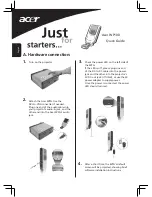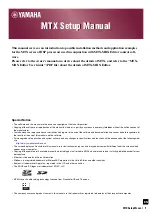
95
LFE level
When a room is set up for multichannel (5.1, 6.1, 7.1) mixing or mastering, the monitoring level of the
subwoofer is set to have an additional 10 dB of inband gain relative to the main channels. This is
transparent to the mixing or mastering engineer, who mixes to and adjusts the LFE channel until it
sounds right. But since the monitoring level of the subwoofer is 10 dB high, the LFE channel will be
recorded 10 dB low. This provides an additional 10 dB of headroom, the reason for the LFE channel.
This is standard procedure, codified in a SMPTE recommended practice and in the Dolby and DTS
specifications.
In order to hear the movie or music the way the mixing and mastering engineers heard it, the cinema or
home listener must likewise have +10 dB inband gain applied to the LFE channel. Virtually all home
multichannel preamplifiers and receivers provide this gain. (In many cases, the post-decoding
analogue outputs of disc players do not.)
Now consider the following case. A Realiser owner goes to a recording studio to capture the sound of
the control room. In that control room, there is no bass redirection and the LFE +10 dB gain is applied
at the subwoofer amplifier, downstream of the Realiser. The Realiser’s test signals are boosted by the
gain at the subwoofer and the boosted LFE becomes part of the PRIR.
Then the owner takes the PRIR home, where his Realiser is connected to a receiver. The receiver
boosts the LFE channel by 10 dB and sends it to the Realiser. Within the PRIR is the +10 dB gain of
the virtual subwoofer. So the LFE channel is played back in the headphones at +20 dB, 10 dB too
high. (The preamplifier or receiver may allow adjustment to remove the +10 gain, but the owner will
need the gain for his physical subwoofer.)
Notice that the Realiser is operating precisely as it should. Exactly the same thing would happen if the
user took the receiver into the studio and connected it. Then +10 at the receiver would be added to +10
at the real studio subwoofer for +20.
In the following table, “upstream” of the Realiser refers to a preamplifier or receiver or other source
connected to the Realiser inputs. “Downstream” refers to processors or amplifiers past the output of
the Realiser. The situation described above is the third of the four entries in the table.
For each case, the LFE gain at the Realiser input is stated in the third column, and the boost in the
PRIR is listed in the fourth column. The object is to get the st10 in the headphones. This can
be done in by setting
SW REL VOL
as shown in the fifth column. The sum of the three columns is
+10, the desired result. (To adjust
SW REL VOL
, press
MENU-SW
, then select
SW vSPKR SETUP2
, then select
REL VOL
.) To save the
SW REL VOL
setting, save or re-save
the preset.
Measured system
Playback system
LFE at Realiser input
PRIR SW
SW REL VOL
LFE gain upstream
LFE gain upstream
+10
0
0
LFE gain upstream
LFE gain downstream
0
0
+10
LFE gain downstream
LFE gain upstream
+10
+10
-10
LFE gain downstream
LFE gain downstream
0
+10
0
The table above is valid when there is no redirection in either the measured or playback system. But
redirection must also be considered.










































